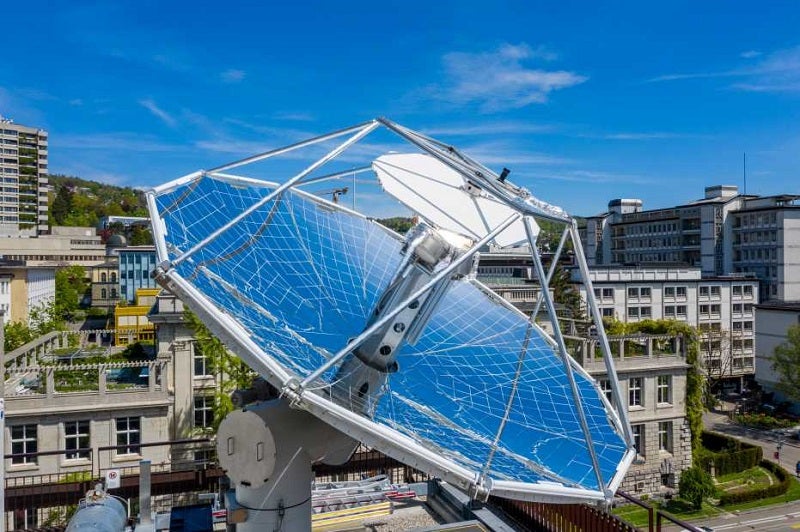
As the energy sector attempts to transition to renewable sources of energy and countries set ambitious carbon emissions targets, development of low-carbon technologies is more important than ever.
Developing low-carbon alternatives to conventional fuels for the transport industry is an important part of these efforts, as maritime transport and aviation are essential parts of global trade as well as energy transition infrastructures.
A research group led by ETH Zurich renewable energy professor Aldo Steinfeld have developed a solar plant capable of producing synthetic liquid fuels from sunlight and air. These liquid hydrocarbons release as much CO₂ during their combustion as was extracted from the air to produce them.
How does the technology work?
The solar plant developed by ETH Zurich combines three thermochemical processes to create liquid fuels from sunlight and air; direct air capture, solar redox and gas-to-liquid conversion.
A Direct Air Capture unit first extracts CO₂ and water from ambient air, which is then fed into a solar reactor which generates heat of around 1,500°C through the concentration of solar radiation.
A ceramic structure made of cerium oxide inside the reactor then enables a reaction that splits the water and CO₂ into a mixture of hydrogen and carbon monoxide known as synthesis gas (syngas). This gas can then be processed into liquid hydrocarbon fuels through the use of a Gas-to-Liquid unit.

US Tariffs are shifting - will you react or anticipate?
Don’t let policy changes catch you off guard. Stay proactive with real-time data and expert analysis.
By GlobalData“Using concentrated solar radiation, a high-temperature solar reactor splits CO₂ and H2O extracted directly from air and produces syngas – a specific mixture of H2 and CO – which is finally processed into liquid hydrocarbons such as methanol or kerosene,” Steinfeld explains.
“The successful operation of the solar demonstration plant represents a crucial milestone towards the production of carbon-neutral synthetic fuels, which release only as much CO₂ during combustion as was previously extracted from the air.
“These drop-in fuels are compatible with the worldwide existing infrastructures for fuel distribution, storage and utilization, and can particularly contribute to sustainable aviation and shipping,” says Steinfeld.
Is the technology viable?
The team at ETH Zurich have proved the feasibility of the technology on a small-scale through a solar mini-refinery on the roof of ETH Zurich. The mini-refinery produces around one decalitre of fuel per day, even under Zurich’s climate conditions.
But this, according to Steinfeld, proves that carbon-neutral hydrocarbon fuels can be made from sunlight and air under real field conditions.
“The thermochemical process utilises the entire solar spectrum and proceeds at high temperatures, enabling fast reactions and high efficiency,” says Steinfeld.
However, this production volume is still too low for commercial use and production costs are high. The next stage for this technology is scaling it up for industrial implementation. “The technologies can be scaled up to produce carbon-neutral transportation fuels at the global scale without the need to replace the worldwide existing transportation infrastructures,” says Steinfeld.
The team are currently working on a large-scale test of the solar reactor technology in a solar tower near Madrid, in the scope of the SUN-to-LIQUID EU project. The solar tower successfully demonstrated the first synthesis of solar kerosene from CO₂ and water in a demonstration on 13 June 2019.
Spin offs and the journey to full scale commercial implementation
Two spin-off companies have emerged from the research group, focused on making this technology commercially viable; Climeworks, which is commercialising the technology for CO₂ capture from air, and Synhelion, which is commercialising the solar fuel production technology.
Synhelion hopes to launch the first full-size commercial system using this technology by 2025, with a production volume of 10 million litres of methanol per year. “A solar plant spanning an area of one square kilometre could produce 20,000 litres of kerosene a day,” said Synhelion director Philipp Furler.
“Theoretically, a plant the size of Switzerland – or a third of the Californian Mojave Desert – could cover the kerosene needs of the entire aviation industry.
“Our goal for the future is to efficiently produce sustainable fuels with our technology and thereby mitigate global CO₂ emissions.”
The efforts to develop this technology are also likely to be bolstered by developments across the energy sector.
At Bloomberg New Energy Finance’s (BNEF) New Energy Outlook presentation in June 2019, BNEF head of energy economics Elena Giannakopoulou described wind and solar energy as two important renewable technologies, predicting that they would account for 50% of global energy by 2050. These enhanced solar and wind infrastructures will likely pave the way for technology such as the solar refinery to be commercially viable at scale.



